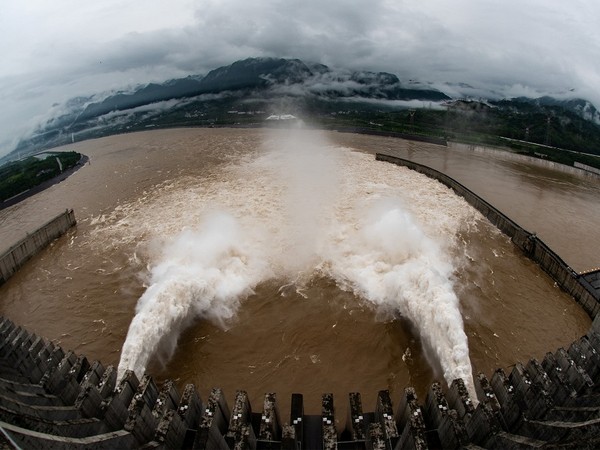
The Three Gorges Dam on the Yangtze River discharges water to lower the water level in the reservoir following heavy rainfall and floods in a few regions, in Yichang, Hubei province, China July 17, 2020. Picture taken July 17, 2020. China Daily via REUTERS ATTENTION EDITORS - THIS IMAGE WAS PROVIDED BY A THIRD PARTY. CHINA OUT. - RC2RWH9ABX3U
Beijing [China], February 28 (ANI): Researchers warned that the overall decline of China‘s Yangtze River waterway will have dire consequences on the environment and the economy of Shanghai– the Beijing’s financial hub, reported South China Morning Post (SCMP).
In a peer-reviewed paper in the journal Advances in Water Science this month, Nie Ning and colleagues with the Ministry of Education’s Key Laboratory of Geographic Information Science pin part of the blame on human activities such as changing landscape and dam construction.
“[But] climate change played a much bigger role than any other factors [in the decline],” they said.
Home to 460 million people, the Yangtze region encompasses the economic powerhouse of Shanghai and accounts for more than a third of China‘s GDP.
Throughout history, its water resources have been a source of wealth, enabling food production and transport.
After examining decades of records from ground stations and satellite images, government researchers estimated that the average level of the Yangtze River has fallen by about 2cm (0.8 inches) every five years since the 1980s.
Stephen Chen, in an article in SCMP, wrote that the river’s ill health will have far-reaching consequences. More than 1,000 lakes disappeared along the waterway, he added.
Xie Zhicai, a researcher from the Institute of Hydrobiology at the Chinese Academy of Sciences in Wuhan, said less water could have ripple effects on the rest of the environment.
“[For example] the concentration of pollutants can increase in the river and poison more vulnerable species,” said Xie, who was not involved in the study.
The ecological balance could tip towards species that favoured a drier environment and if that happened too quickly, certain plants and animals could become extinct, he said.
Less water also means dams played a bigger role in water management, disrupting natural cycles. Some fish species such as sturgeon were sensitive to changes in temperature and water level.
“The disruption can affect their reproductive activities,” Xie said.
Nie’s team concluded that climate change contributed to nearly 80 per cent of the decline, with abnormal climate events such as rising temperatures in some parts of the Pacific Ocean reducing the overall rainfall going into the Yangtze, reported SCMP.
Warmer temperatures also increased the fluctuation of water reserves, leading to more floods and droughts, they said.
Evaporation increased as well, partly because of higher temperatures, partly because of human activities, with ever-growing cities accelerating the loss of water into the atmosphere.
The role of dams was more complex. The operations of 15 major dams including the ‘Three Gorges’ caused the water levels to fall in winter and spring, but rise in warmer periods. Overall the dams had a negative, though relatively small impact, on the amount of water, according to the researchers.
A Beijing-based water scientist said the water decline in the Yangtze might be worse than the paper’s estimate. Each day, a large but undisclosed amount of water is drained from the Yangtze and channelled up north to thirsty cities including Beijing.
More than half the water consumption in the capital comes from the Yangtze, according to the municipal authorities.
“Throughout history, water distribution issues have sparked fights between regions,” said the researcher who declined to be named because of the political sensitivity of the issue. (ANI)

















